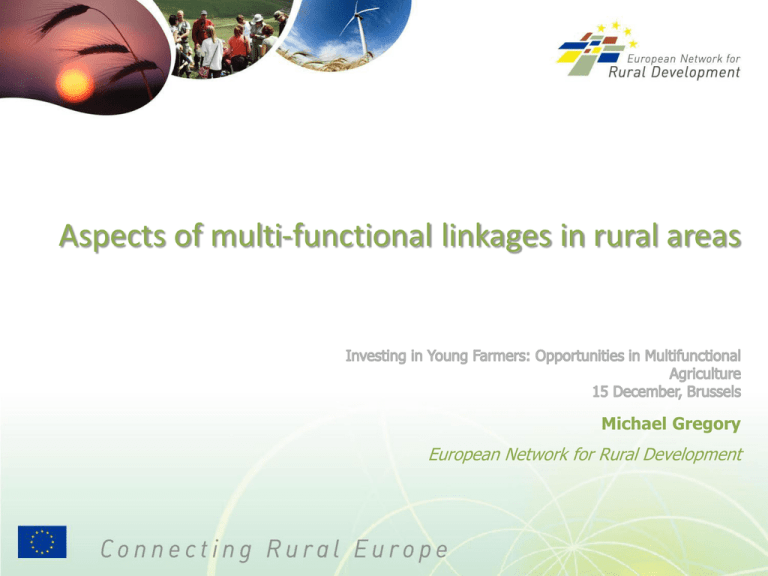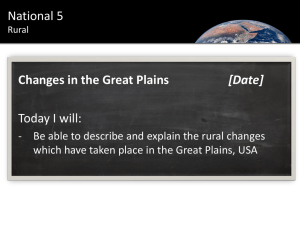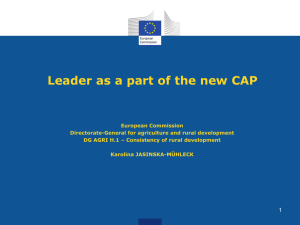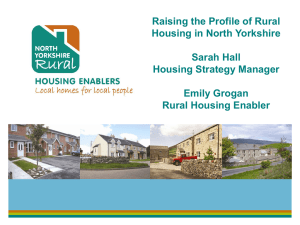What is a public good?
advertisement

Aspects of multi-functional linkages in rural areas Michael Gregory European Network for Rural Development Objective of this presentation © ENRD Contact Point To describe the strength of economic linkages between agriculture and the rest of the rural economy in selected NUTS 3 regions throughout the EU …and illustrate that the provision of ‘public goods’ can be a significant part of the ‘multifunctionality’ mix of farms and rural enterprises. 2 Basis of the analysis presented • The EN RD Thematic Working Group No.2 studying ‘Linkages between agriculture and the wider rural economy’ • Quantitative and qualitative analysis was conducted in 18 NUTS 3 rural areas throughout the EU and followed-up by further study in selected regions and a wide-ranging exercise to identify and assess specific project interventions. 3 Choice of NUTS3 Regions: 4 Clustering of regions: • Non-dynamic areas: ▲ • Agriculturally-dependent dynamic areas: ▲ • Diversified dynamic areas: ▲ 5 Low backward linkages: Major imported Inputs Seed Fertilizer Plant Protection Major Products Backward Linkage 1.273 Indirect effects 0.242 Most Important Backward Relation Wheat Trade (0.064) Backward Dispersion 0.667 Machinery Backward Interconnectedness 2.583 Irrigation Output Elasticity 0.092 Income Elasticity 0.111 Cotton Milk Meat Pine Wood Locally Produced Inputs Fish Farming Feedstuff 6 High forward linkages: Direct links Indirect links Total forward: 2.589 Flour Mills Indirect effects 1.533 Forward Food Industry 0.272 Ginners Forward Trade 0.201 Milk and Dairy Forward Hotels & Catering 0.118 Bakeries Pasta Trade Textiles Trade Milk Cheese Tourism Trade Meat and Meat Food Industry Products Tourism Trade Forward Dispersion 1.247 Wood Wood Industry Construction Furniture Trade 7 Initial Input/Output Analysis results: Comparative analysis between clusters reveals: • • • • • Backward linkages are generally quite low in all 3 clusters Forward linkages are generally strong in all 3 clusters Trade, Hotels & Catering appear to have high backward & forward links with the rest of the economy, in all 3 clusters Diversification appears to be higher in Diversified Dynamic areas than other clusters Accessibility + competitive agri-food chain critical factors underpinning agricultural links with the rural economy 8 Diversification trends: • Tends to occur/have greater chances in areas where there are ‘real’ alternatives • Where diversification policies have been aggressively promoted they have tended to result in shorter term, less sustainable outcomes • Where agriculture is a significant sector, it tends to offer the best opportunities for specialisation and investment 9 Project level characteristics - general • Evidence in all the selected regions of a wide range of EAFRD supported projects which demonstrate multifunctionality (both on and off farm income generation) • Local people / entrepreneurial spirit are key main drivers in building linkages • High impact of local institutional arrangements 10 Project level characteristics – investments which additionally generate ‘public goods’ In the EAFRD supported projects identified, analysed and found to be generating positive outcomes: • Over 20% generate additional environmental and/or social public goods • These public goods benefits are often identified a priori – but may be more substantial than expected. • Additional non-planned environmental and/or social benefits may also be generated. • These extra benefits would not have been materialized without policy intervention. 11 Possible RD policy implications to consider include: • Investments (supported by RD funds) propensity to create successful - economically positive - linkages would be higher with a more cross-cutting and integrated programming approach • For the current programming period – possibility for improved selection criteria and technical and marketing support at the project level • For the future – [more] explicit recognition of the multiplier effect of agriculture - ‘embedding’ linkages between agriculture and other sectors of the economy in the programming framework – more focussed territorial targeting 12 For more information please visit EN RD website: • TWG1: http://enrd.ec.europa.eu/thematicinitiatives/twg1/en/twg1_home_en.cfm • TWG2: http://enrd.ec.europa.eu/thematicinitiatives/twg2/en/twg2_home_en.cfm • TWG3: http://enrd.ec.europa.eu/thematicinitiatives/twg3/en/twg3_home_en.cfm 13 Selected case study examples – illustrating the provision ‘public goods’ (both environmental and social) as part of the multifunctionality mix 14 Adding value to agricultural and forestry products “La ferme du Hourcot”, Ornezan, Gers (FR) Establishment of cheese factory within a farm producing cereals, milk and cheese. Main goal : to produce highquality cheese and take control © ENRD Contact Point of the whole production chain, including direct sales to local consumers. Environmental sustainability is a major focus of the operation of the farm and is significantly “valued in the market” (photovoltaic panels, homeopathy products used to treat animals, no-tillage farming techniques) 15 “La ferme du Hourcot”, Ornezan, Gers (FR) Public Goods provided © ENRD Contact Point © ENRD Contact Point © ENRD Contact Point Rural vitality: new jobs (plus farm succession) Air quality, animal welfare, soil functionality, biodiversity. 16 Adding value to agricultural and forestry products “Dairy plant Ema Mejeri”, Kalmar Ian (SE) • Establishment of a local dairy plant and production and distribution of milk and dairy products to a local market • Main goal was to offer owners (two farmers implementing the project) an alternative market, through the control of the whole production chain and the sales of high quality dairy products to local consumers. • Environmental sustainability is promoted through a reduction of transportation effort • Rural vitality: very significant impacts; creation of 20 new jobs; additional farmers provide milk to the firm (spillover); higher local incomes; rural economic diversification; mobilization of local actors. 17 Diversification into non-agricultural activities © ENRD Contact Point “Maison de l’ail”, Saint Clar, Gers (FR) • Establishment of a garlic museum; tourist facility attracting customers (direct sales). • Main goal was to create event and tourism activities out of their farm product and increase their income. 18 “Maison de l’ail”, Saint Clar, Gers (FR) Public Goods provided © ENRD Contact Point © ENRD Contact Point © ENRD Contact Point Rural vitality: maintenance of jobs; higher income; rural identity (spillover to other local farms and sectors - synergy) Environmental sustainability: farmland is kept as a natural prairie; very low use of pesticides. 19 Support for business creation and development © Erdäpfelregion Lainsitztal “Sales promotion and awareness of potatoes”, Waldviertel (AT) • Establishment of a network which aims at the strengthening of cooperation between potato producers, restaurants and accommodation firms. • Main goals were to: develop highquality organic products and utilize modern marketing strategies in order to link the local area image with these products. 20 “Sales promotion and awareness of potatoes”, Waldviertel (AT) • Environmental sustainability: the project involves organic farms. • Rural vitality: creation of new jobs in several sectors (agriculture, food processing, catering, etc.); higher incomes; rural identity (spillover to local sectors). © Erdäpfelregion Lainsitztal Public Goods provided 21 Diversification (Leader approach) “Mantania Tower Traditional Hotel”, Trikala (GR) Establishment of a medium-sized rural accommodation unit in an area characterized by its high natural and aesthetic value. The aim was to establish an accommodation which respects local architecture and offers a wide range of services specific to the area (restaurant serving traditional local food; small shop selling local products; organization of “truffle days” and mushroom collection). 22 “Mantania Tower Traditional Hotel”, Trikala (GR) Public Goods provided Environmental sustainability: compliance with local traditional architecture; commodification of natural and aesthetic value of the area. Rural vitality: creation of a significant number of new jobs; higher incomes; rural identity (spillover to local sectors). 23







